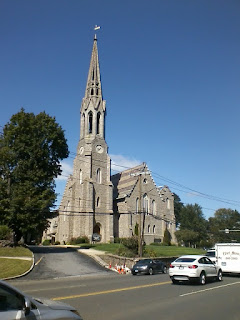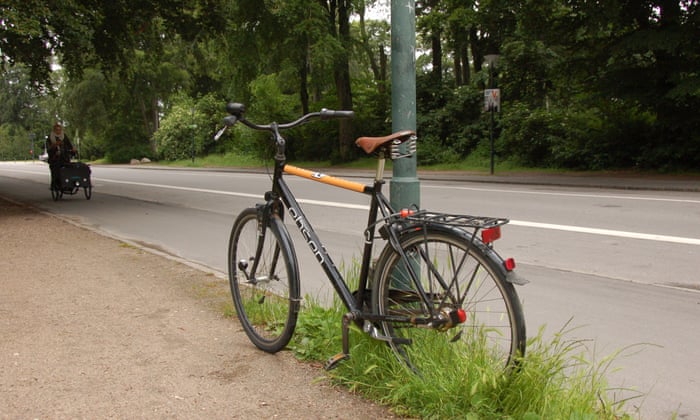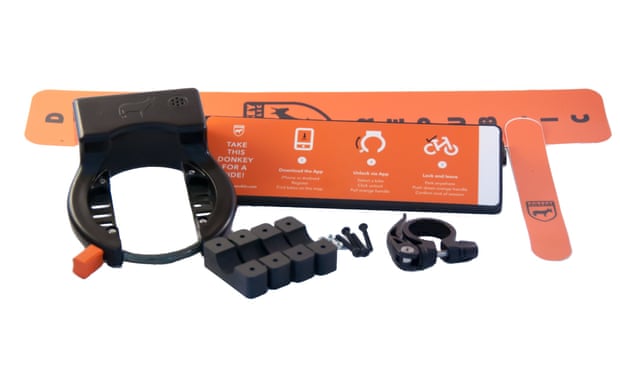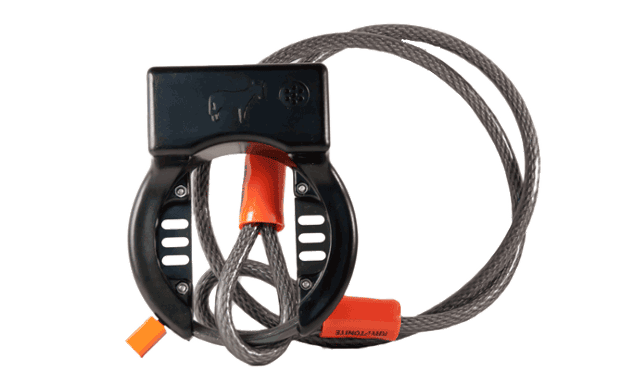A few days ago "The Retrogrouch" alerted us to a disc brake failure reported on Bike Radar.
One of BR''s test riders was riding a Specialized Tarmac Pro with Shimano R 785 disc brakes through Rocky Mountain National Park, on a course with some long and steep climbs and descents. It's really not the sort of ride on which you want to lose your braking power.
The rider, Ben Delaney, describes what happened on a descent: "I felt my rear brake go soft for perhaps 30 seconds, with the lever feeling mushy, and then go out completely. Pulling the lever all the way had zero effect on the rear caliper."
Fortunately for him, he didn't crash and his front brake still worked well enough for him to complete his ride, and he wasn't hurt. After the ride, he contacted Shimano and they retrieved the hose and caliper.
According to Shimano America road product manager Dave Lawrence, the failure was the result of an oil leak caused by a crack in the right side piston. That crack wasn't caused by heat generated from braking, according to Lawrence's report. The investigators observed slightly higher-than-normal disc pad contact with the rotor. "We have made several machine and riding tests in similar conditions, and we have not been able to replicate similar damage to the piston", the report continues.
What, exactly, caused that piston to crack is a fair question: one that neither Shimano nor anyone else seems able to answer. To be fair, that alone is not a wholesale indictment of disc brakes or Shimano. However, it does beg the question of just how sensible or necessary disc brakes are for bicycles.
On the few occasions when I felt my cable-and-caliper (i.e., dual-pivot or single pivot sidepulls, centerpulls, cantilevers or V-brakes, all of which I have used at some point or another) losing power or modulation, I didn't completely lose my braking ability and, when I stopped, I was able to spot and fix the problem quickly. And, even when riding with loaded panniers in the Alps, Rockies, Pyrenees, Adirondacks and in the Green Mountains, whatever caliper brakes I used were sufficient as long as my pads and cables were good.
Now, I've worked as a mechanic in bike shops. But even before I started doing so, I'd taught myself how to fix my brakes, as well as other parts of my bike. A cable-actuated caliper brake system can be adjusted with a minimum of tools: In fact, most can be done without specialized bicycle tools (although said specialized tools certainly make the job easier and faster). There is certainly something to be said for such simplicity when you're 100 kilometers from the nearest village.
Also, as "The Retrogrouch" points out, hydraulic disc brakes in cars and trucks are larger and more robust, and more protected from the elements, than any disc brake that could ever be fitted to a bicycle. The ones scaled down to fit bikes will be more finicky and thus more prone to breakdowns--not to mention adding weight and complication to the bicycle.
The disc brake failure experienced by Delaney of Bike Radar, and relayed to us by "The Retrogrouch" is also not the first such failure. In fact, bicycle disc brakes were failing in the 1980s, long before Shimano ever thought to manufacture them.
In those days, high-quality racing tandems were usually fitted with front and rear cantilever brakes, while touring tandems added a third caliper brake (usually a sidepull) on the rear. A few tandems, usually custom-made, came with a drum brake attached to the rear hub. The best of them was made by Arai in Japan.
For a time, some custom tandems came with this rear disc brake made by Phil Wood:
It's certainly an impressive piece of machinery, as most of Phil's products are. Trust me; I know: I use some of them,
The disc, made of an asbestos composite, was attached to the hub by a series of splines. Those splines were prone to stripping, which caused a loss of braking. To Phil Wood's credit, they responded to the situation rather quickly: After only a few reports of incidents (none of which resulted in injury), the brakes were pulled from the market.
Again, I emphasize that while I question the wisdom of using disc brakes on bicycles, I do not believe that the problems or incidents I've mentioned are an indictment of disc brakes themselves. Rather, I think they show that Shimano is trying to make something work 30 years after Phil Wood--known for making bike components that work better and last longer than others--couldn't do it. Not all technologies are transferrable from automobiles (or aircraft) to bicycles, and disc brakes might be one of those technologies.
N.B.: Phil Wood discs were manufactured before the ban on manufacturing asbestos products was enacted in 1989. That ban was overturned only two years later under pressure from lobbyists for the asbestos industry.
One of BR''s test riders was riding a Specialized Tarmac Pro with Shimano R 785 disc brakes through Rocky Mountain National Park, on a course with some long and steep climbs and descents. It's really not the sort of ride on which you want to lose your braking power.
The rider, Ben Delaney, describes what happened on a descent: "I felt my rear brake go soft for perhaps 30 seconds, with the lever feeling mushy, and then go out completely. Pulling the lever all the way had zero effect on the rear caliper."
Fortunately for him, he didn't crash and his front brake still worked well enough for him to complete his ride, and he wasn't hurt. After the ride, he contacted Shimano and they retrieved the hose and caliper.
According to Shimano America road product manager Dave Lawrence, the failure was the result of an oil leak caused by a crack in the right side piston. That crack wasn't caused by heat generated from braking, according to Lawrence's report. The investigators observed slightly higher-than-normal disc pad contact with the rotor. "We have made several machine and riding tests in similar conditions, and we have not been able to replicate similar damage to the piston", the report continues.
What, exactly, caused that piston to crack is a fair question: one that neither Shimano nor anyone else seems able to answer. To be fair, that alone is not a wholesale indictment of disc brakes or Shimano. However, it does beg the question of just how sensible or necessary disc brakes are for bicycles.
On the few occasions when I felt my cable-and-caliper (i.e., dual-pivot or single pivot sidepulls, centerpulls, cantilevers or V-brakes, all of which I have used at some point or another) losing power or modulation, I didn't completely lose my braking ability and, when I stopped, I was able to spot and fix the problem quickly. And, even when riding with loaded panniers in the Alps, Rockies, Pyrenees, Adirondacks and in the Green Mountains, whatever caliper brakes I used were sufficient as long as my pads and cables were good.
Now, I've worked as a mechanic in bike shops. But even before I started doing so, I'd taught myself how to fix my brakes, as well as other parts of my bike. A cable-actuated caliper brake system can be adjusted with a minimum of tools: In fact, most can be done without specialized bicycle tools (although said specialized tools certainly make the job easier and faster). There is certainly something to be said for such simplicity when you're 100 kilometers from the nearest village.
Also, as "The Retrogrouch" points out, hydraulic disc brakes in cars and trucks are larger and more robust, and more protected from the elements, than any disc brake that could ever be fitted to a bicycle. The ones scaled down to fit bikes will be more finicky and thus more prone to breakdowns--not to mention adding weight and complication to the bicycle.
The disc brake failure experienced by Delaney of Bike Radar, and relayed to us by "The Retrogrouch" is also not the first such failure. In fact, bicycle disc brakes were failing in the 1980s, long before Shimano ever thought to manufacture them.
In those days, high-quality racing tandems were usually fitted with front and rear cantilever brakes, while touring tandems added a third caliper brake (usually a sidepull) on the rear. A few tandems, usually custom-made, came with a drum brake attached to the rear hub. The best of them was made by Arai in Japan.
 |
| Arai drum brake on Fat Chance tandem, 1985 |
For a time, some custom tandems came with this rear disc brake made by Phil Wood:
 |
| Phil Wood disc brake, 1980s |
It's certainly an impressive piece of machinery, as most of Phil's products are. Trust me; I know: I use some of them,
The disc, made of an asbestos composite, was attached to the hub by a series of splines. Those splines were prone to stripping, which caused a loss of braking. To Phil Wood's credit, they responded to the situation rather quickly: After only a few reports of incidents (none of which resulted in injury), the brakes were pulled from the market.
Again, I emphasize that while I question the wisdom of using disc brakes on bicycles, I do not believe that the problems or incidents I've mentioned are an indictment of disc brakes themselves. Rather, I think they show that Shimano is trying to make something work 30 years after Phil Wood--known for making bike components that work better and last longer than others--couldn't do it. Not all technologies are transferrable from automobiles (or aircraft) to bicycles, and disc brakes might be one of those technologies.
N.B.: Phil Wood discs were manufactured before the ban on manufacturing asbestos products was enacted in 1989. That ban was overturned only two years later under pressure from lobbyists for the asbestos industry.






